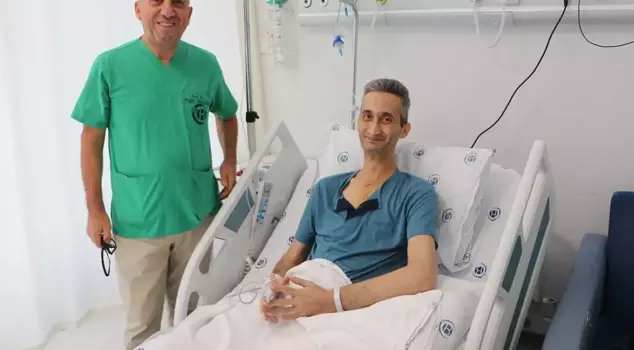
31.08.2025 17:50
Hüseyin Emrah Yıldız, who has a congenital anomaly in his heart valve, was diagnosed with a panic attack after experiencing persistent shortness of breath following two surgeries in Adana. Yıldız, who believed he had been suffering from shortness of breath due to this condition for years, underwent surgery last month at a hospital due to palpitations and arrhythmia. This surgery, which involved the rupture of a balloon inside the heart, marked the third occurrence of such a procedure in the world and entered the medical literature.
A congenital heart valve anomaly patient, Hüseyin Emrah Yıldız, who underwent heart surgery twice at a young age at Çukurova University (ÇÜ) Faculty of Medicine Balcalı Hospital, has been suffering from shortness of breath for 13 years. During this process, Yıldız was referred to psychiatry and diagnosed with panic disorder, leading to years of medication use.
IT EMERGED AFTER A REAL TOOTH EXTRACTION
When the medication was stopped, Yıldız's breathing problems reappeared. A few months ago, after a tooth extraction, he experienced arrhythmia and palpitations, prompting him to visit the emergency department. After examinations, cardiologists identified a problem with his heart valve and referred Yıldız to Prof. Dr. Mehmet Şah Topçuoğlu, a faculty member of Adult and Pediatric Cardiovascular Surgery at ÇÜ Faculty of Medicine Balcalı Hospital. In the surgery performed by Topçuoğlu and his team, three separate procedures were carried out, and Yıldız regained his health after a 6-day intensive care process.
"I THOUGHT I WAS A PANIC DISORDER PATIENT"
After the last surgery, Hüseyin Emrah Yıldız stated that he can now breathe comfortably, saying, "I was born with some heart-related issues. I had surgery twice. I thought my heart problems were over. However, I was constantly experiencing shortness of breath. They referred me to psychiatry. I was diagnosed with panic disorder. I thought I didn't have any heart-related illness and that I was just a panic disorder patient. A few months ago, I went to the emergency department with complaints of arrhythmia and palpitations. The cardiologist said there was a problem with my heart valve and that only Prof. Şah could perform this surgery. My surgery was very successful. I only stayed in intensive care for 6 days and had an easier process compared to my previous surgeries. I feel very good right now. When I came out of surgery, the first thing I did was check my breath. I can now breathe very comfortably," he said.
THE BALLOON BURST IN THE HEART FOR THE 3RD TIME; ENTERED MEDICAL LITERATURE
Prof. Dr. Mehmet Şah Topçuoğlu, who performed the surgery, stated that the patient has entered medical literature, saying: "The aortic valve in the heart consists of three leaflets. In some children, the bicuspid valve, meaning the aortic valve is formed of two leaflets congenitally, occurs. This creates a weakness in the aortic wall and leads to a clinical picture known as sinus valsalva aneurysm, or ballooning. The frightening and deadly aspect of this is the rupture of that balloon expanding into the heart. It occurs in 1 or 2 patients per 100,000. Our patient had previously undergone surgery twice due to sinus valsalva aneurysm. Generally, if performed in experienced hands, the success rate is high after the first repair. He came to us for the third time due to the rupture of the balloon. The ballooning was completely removed during the surgery. That area was closed with bovine pericardium. Since the patient had a bicuspid aortic valve, and its functions were limited, we also replaced it with a mechanical valve. Additionally, since the patient's aorta had thinned due to this condition, we completed our surgery by replacing the aorta over the coronary sinuses. We performed three separate procedures in the approximately 7-hour surgery.
"THE FIRST PATIENT IN THE WORLD"
There has never been a patient in the world literature who has undergone surgery for the third time due to the rupture of the sinus valsalva aneurysm, or ballooning, in the heart. This patient has entered the literature in this regard. He is currently in good health, walking, and will return to his daily life shortly."